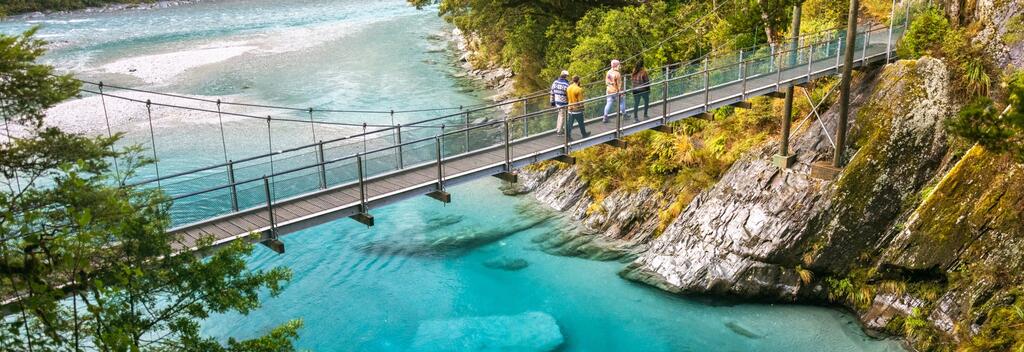-
Popular places to visit
Popular things to do
Helpful tips
Here's a few useful links to help with planning your trip to Aotearoa New Zealand.
-


Stretch your legs and feed your soul in this beautiful wilderness of native forests, towering mountains and long river valleys.
Named for Mt Aspiring, one of New Zealand's highest peaks, this park is a dreamland of mountains, glaciers, river valleys and alpine lakes.
A hiker's paradise, Mount Aspiring National Park offers a large number of short walks that are mostly concentrated at the end of the park's access roads.
Longer hikes through beautiful valleys, with options to traverse mountain saddles, include the Routeburn, the Dart/Rees River circuit, Greenstone/Caples and the Wilkin Valley tracks. In summer, it’s possible to walk from one valley to another over spectacular mountain passes. Shorter walks include Routeburn Nature Walk, Haast Pass Summit, Lake Sylvan near the lower dart River and the Blue Pools Walk. A highlight of any South Island adventure, the 30-minute Blue Pools Walk leads through silver beech/tahina forest and over a swing bridge to a viewing platform overlooking magnificent crystal-clear pools at the mouth of Blue River.
In the past, Māori trekked through the region on their way to the pounamu fields of the west coast; Europeans visited to map, name and explore geographical features of the area; settlers attempted to farm and mine some of the valleys - the relics have blended into the stunning scenery.
In straddling the 'great divide' of the Southern Alps, the Mount Aspiring National Park presents a breath-taking range of landscapes.
At its heart is a massive area of wilderness - glaciers, snowfields, mountains, valleys and wildlife habitats that require days of hiking to reach. To the west of the divide, where rainfall is plentiful, the beech forest comes with a sound track of birdsong and waterfalls.
Deep in the glacier-gouged valleys of the east, grassy river flats are hemmed by imposing mountains. And above the tree line, subalpine gardens of tussock, lichens and dainty flowering herbs survive against all odds.
Rock forms are an unforgettable feature of the park. From the curiously coloured slopes of the Red Hills to the brittle grey schist of the Alps, ice ages and huge tectonic upheavals have created beauty with a hard edge.
The only source of accommodation within the park is provided by the Department of Conservation(opens in new window). There are numerous hikers' huts along the major walks, including two 'Great Walk' huts on the Routeburn Track. Many of the tracks also have established camping areas. Huts need to be booked during the summer high season.
The settlements of Makarora, Haast and Glenorchy act as gateways to the park. Makarora has B & Bs, cottages, chalets, farmstays and camp sites. Accommodation in Haast and Glenorchy includes motels, hotels and lodges.
Summer is the best time to walk the 3-day Routeburn Track, which runs between Lake Wakatipu and the Te Anau-Milford Road. The Rees-Dart track, a 5-day tramping circuit, follows the Rees River and the Dart River through the southern end of the park. From Wānaka, popular short walks include the Aspiring Hut walk (1 ½ hours) and the Rob Roy track (1 ½ hours). Good short and long walks can also be accessed from Makarora.
Another great walk is to the beautiful Blue Pools(opens in new window). Walk a short 1.5km loop through beautiful beech forest before arriving at the icy glacier-fed waters. This walk is suitable for children.
Some of the park's rivers such as the Dart, the Wilkin, and the Matukituki River are navigable by jet boat. Often jet boat trips are combined with a valley walk, to create a well-rounded adventure.
The Park provides mountaineers with a wide choice of ascents - from Mt Awful to Mt Aspiring. Local guiding companies provide instruction for would-be mountaineers. Exceptional heli-skiing can be found on the Northern Buchanans and Albertburn.